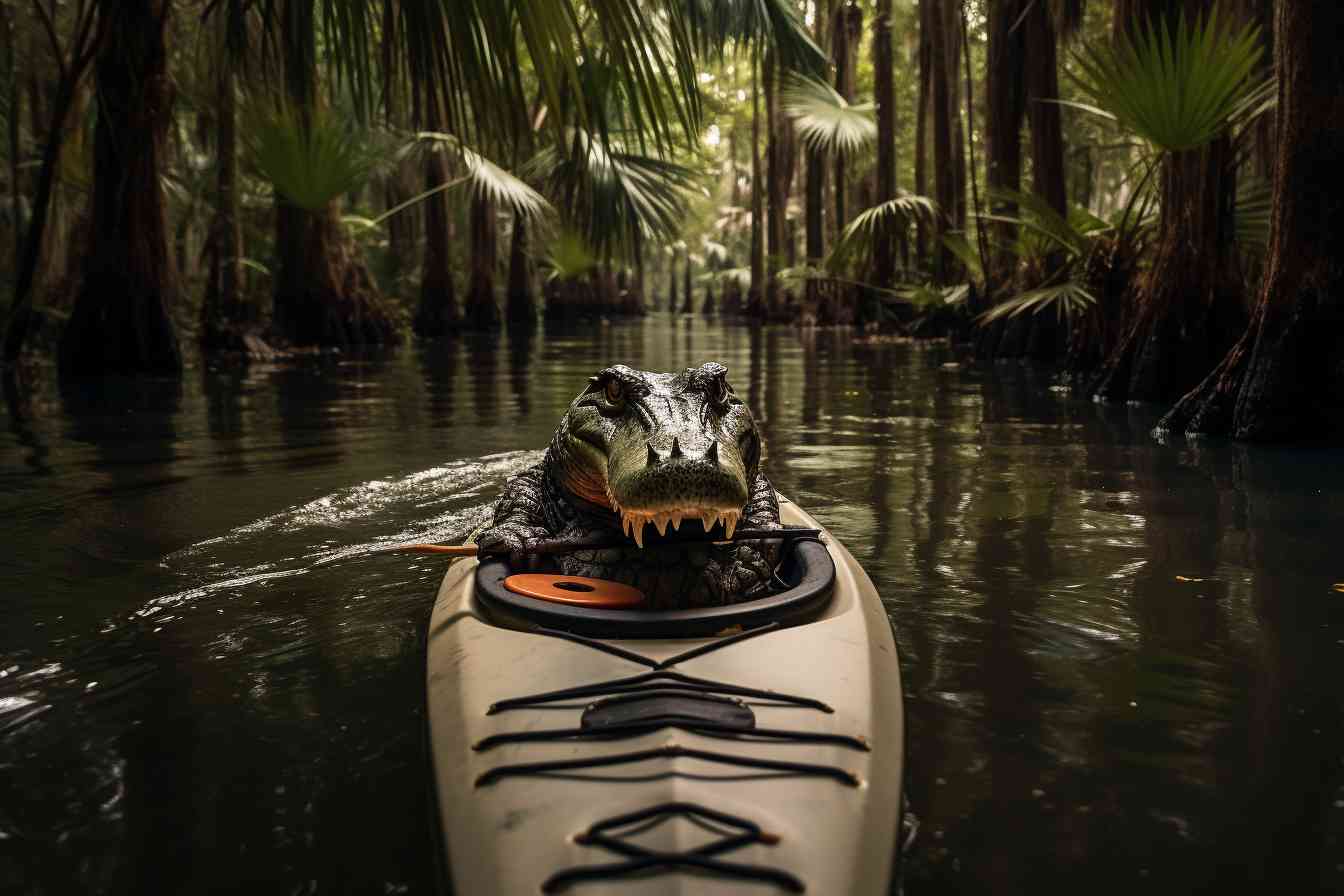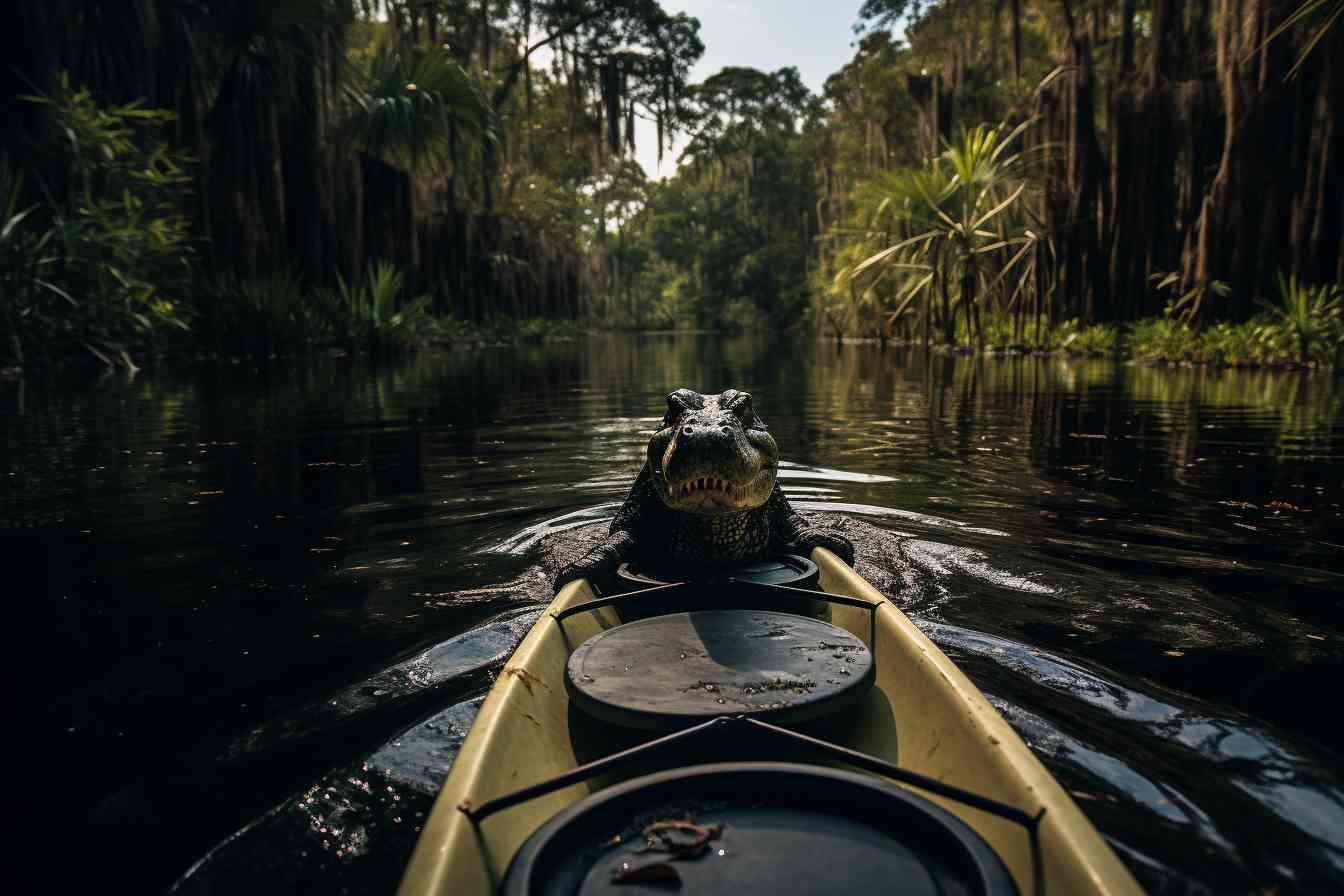Intro: Kayaking With Alligators

Alright, y’all, let’s face it – there’s nothing quite like being out on the water, cutting through the waves with your kayak. But add a couple of alligators into the mix and you’ve got yourself an adrenaline-pumping adventure that’s not for the faint of heart and yet, is quite an exhilarating experience. Now, I’ve seen my fair share of gators while out on my excursions, mostly in the tropical swamps, rivers, and estuaries where these fascinating creatures like to hang out.
Kayaking with alligators… just the thought of it might make your heart skip a beat, right? But, worry not as it’s not as petrifying as it sounds. It does, however, require you to be extremely aware of your surroundings. You’d need to respect the creatures’ space, ensuring you don’t invite any unnecessarily dangerous interactions.
You see, alligators are generally indifferent to our presence unless threatened or if it’s a momma gator protecting her babies – I reckon that’s something we can all relate to! So, it’s imperative that you keep a safe and respectful distance when you spot them sunbathing on the banks or just sliding into the water. It’s all about co-existing peacefully.
However, you need to remember, you’re in their territory and the rules of the jungle apply. Avoid nighttime kayaking as gators primarily hunt in the dark and remember, splashing attracts them. Also, steer clear of any nesting areas, if you see baby gators, paddle away promptly, as female alligators are extremely protective.
In conclusion, kayaking with alligators can be an unmatched experience filled with excitement, respect for wildlife, and even a little daring. However, practicing proper safety measures keeps the experience both thrilling and safe. So gear up, paddle on and embrace the incredible scenery and wildlife around you.
Are Kayaks Safe Around Alligators?

Hey there, kayaking enthusiasts! I guess y’all are wondering – is being around alligators safe? Well, lemme give you the lowdown. It’s a query that comes up frequently in our spicy, adrenaline-packed world of kayaking. And let’s face it, the notion of being close to an alligator could send shivers down anyone’s spine, right?
Well, folks, it’s not as scary as you might think! I mean, I have been in these situations numerous times. There’s a kind of mutual respect between me and these ancient creatures. They get it – I’m just passing through their habitat without causing ruckus. The mere presence of a kayak doesn’t necessarily mean an alligator will see you as a threat or, heavens forbid, a juicy snack!
In fact, alligators generally keep their distance unless provoked. Now, mind you, don’t go trying to offer an alligator a treat or play with their tail- that’s a no go! Be aware, don’t feed them and keep a respectful distance. Seriously, they aren’t plush toys folks.
But hey…if you’re in a bit of a close encounter, just stay calm and paddle away slowly. Their eyesight isn’t the best and sudden movements might spook ‘em. So, there you have it. Kayaking around alligators? It can be safe, but you have to be smart about it. Remember, they were here long before us. We’re just visitors in their world.
So, what’s the takeaway? Kayaks are indeed safe around alligators, provided you respect their space and don’t act in a way that causes them to feel threatened. It’s about understanding the environment you’re in and behaving accordingly. We’re guests in their space, after all.
Well, I believe I’ve said my piece and now it’s up to you! Respect is crucial. We love kayaking, we love nature, and all the creatures within it. That includes the alligators. Safe paddling, everyone! And remember to always paddle with caution and respect for nature.
Is It Safe To Swim Around Alligators?

Whew, talk about testing the waters with a daring question – is it safe to swim around alligators? Now, I ain’t no alligator whisperer, but let me air out my thoughts here.
First off, alligators are complex creatures – surprisingly shy, but also fiercely territorial. Even though they’re not naturally aggressive towards humans, they won’t hesitate to protect their turf. Unpredictable, that’s what they are. Swimming with them? Well, that’s kind of like playing tag on a tightrope – thrilling but potentially disastrous.
A few things to keep in mind – an alligator? It’s fast in the water. Faster than you or me – and that’s a fact. In their element, they’re agile, stealthy, and well capable of launching sudden attacks.
But here’s the silver lining – they general want to avoid us as much as we want to avoid them. Mature alligators typically steer clear of humans and only become hostile when they feel threatened. It’s crucial, then, not to provoke one, intentionally or otherwise. Avoid splashing loudly or making sudden movements that might alarm them.
And let’s not forget the golden rule – never feed an alligator. It’s illegal, for starters. More importantly, it encourages them to associate humans with food, which can alter their behavior and make them more likely to approach people. That’s the last thing we want.
If you ask me, I’d recommend only hitting the water with a well-organized, expert-led group if you’re keen on swimming near these critters. Safety should always be your top priority. So, is it safe to swim around alligators? Meh, it’s a toss-up. You got to weigh out the thrill against the risk. Happy paddling, folks, and remember – keep it safe!
Where Can You Kayak In Florida Without Alligators?

Alright then, let’s get down to the nitty-gritty. You’re probably raring to know where you can kayak in Florida without the fear of bumping into an alligator? Well, dear reader, rest assured. There’s no shortage of great, gator-free kayaking spots in the Sunshine State.
The city of Clearwater, for instance, is a splendid place to begin your adventure. Whether you’re new to the sport or an old hand at it, Clearwater’s gentle, crystal-clear waters offer some of the best paddling opportunities – and I mustn’t forget to mention, without a single gator in sight!
Another place worth a mention is St. Augustine. This town, with its blissfully alligator-free rivers, is an abode for a variety of aquatic life and vibrant seascapes that make every kayaking expedition a delight.
There’s something else that’s really intriguing about Florida – the number of bioluminescent kayaking tours available. Indian River Lagoon and Merritt Island National Wildlife Refuge are two such spots where you can paddle alongside glowing marine creatures under a starlit sky, sans any alligators. It’s quite surreal, really.
Of course, it’s critical to note that while these spots are generally recognized as gator-free, always maintain a vigilant eye! And remember – no feeding of wildlife, okay? Happy paddling!
So , there’s your answer folks . It’s quite possible to enjoy the thrill of kayaking in Florida without the unexpected company of alligators . Isn’t that a relief ?
What Does The Closest Alligator To The Boat Mean?
Well, when you’re out on the kayak, you might see an alligator floating nearby, right? I mean, that’s part of the thrill, isn’t it? Let’s dive in and talk about what the closest alligator to the boat actually means.
Now, you need to get this straight—gators aren’t typically aggressive. Most of the time, they’re just as curious about you as you are about them. However, don’t mistake this curiosity for an invitation to get up close and personal. Alligators are wild animals, for crying out loud!
If there’s an alligator near your kayak, it could mean several things. I mean, it could just be chilling and you happen to be in the way. Or, more concerning, it could be checking you out, trying to determine if you’re a threat or… let’s not even go there.
But here’s the crux – if an alligator approaches your boat, stay calm. I’m not joshing. The last thing you want is to startle it and provoke an attack. Keep your distance, avoid sudden movements, and whatever you do, don’t feed it! They’re not your pets.
And her’s a free tip – making yourself look big can often discourage further approach. With alligators, it’s all about respecting their space and not pushing your luck.
But remember, always be on the lookout. Spotting an alligator close to your kayak could simply be a sign that you’re in their territory and you need to be mindful. And, more importantly, always consult with local wildlife experts and guides who know these creatures and can help you navigate these waters safely. Playing cowboy with alligators? Thas’s certainly not a good idea! Keep these pointers in mind and you’ll have a great kayaking experience.
Final Verdict
Alright, let’s gab about the on kayaking with alligators. Now, I wouldn’t lie, the thought of sharing water with these reptiles might give you a bit of the heebie-jeebies. But… hear me out. I’m not suggestin’ you go play tag with ‘em, but under the right circumstances, with the proper precautions, it can actually be an exhilarating experience, and not as dangerous as it first appears.
Alligators, you see, generally avoid human encounters as much as possible, but the key is to respect their space. Maintain a healthy distance, avoid feeding them, and whatever you do, don’t disturb nesting females. She’s not one to trifle with and will teach you the definition of protective mama bear, or should I say, mama gator.
It’s also crucial to remember when you’re paddlin’ that alligators are part of the ecosystem you’ve chosen to explore. Respect them, respect the environment… it’s all part of the adventure, right?
Sure, kayaking with alligators may not be everyone’s cup of tea, but how about we drop the fear and embrace the thrill? After all, isn’t life about pushing boundaries and exploring the wild? So, the final verdict? Take the plunge (metaphorically speaking, please), but paddle with caution. The beauty of nature, even in its most intimidating form, is worth experiencing.
Frequently Asked Questions
Q1: Is it safe to kayak with alligators?
Ah, the age-old question! Generally speaking, alligators are not interested in humans unless provoked. Though it can be unnerving to see a gator while kayaking, they usually keep their distance. That being said, always stay alert, keep your distance, and never feed them.
Q2: What should I do if I see an alligator while kayaking?
First of all, don’t panic. Alligators are typically more scared of you. Keep your distance, don’t make sudden movements, and never provoke them. If the alligator does approach you, making a lot of noise usually will scare it away.
Q3: Can an alligator flip a kayak?
Well, technically, yes, an alligator could flip a kayak. It’s, however, extremely rare. Alligators are usually uninterested in kayakers. Stay calm, maintain your distance, and you’ll likely coexist peaceably.
Q4: Are there certain places to avoid kayaking because of alligators?
Actually, there are. Places with ample food sources like marshlands or swamps may have a greater alligator population. It’s best to research and talk to local experts before you set off on your adventure.
Q5: What time of day are alligators most active?
Alligators are most active between dusk and dawn. So, if you’re not keen on meeting one during your kayaking trip, daytime paddling is your best bet!
Q6: What’s the biggest alligator ever seen by kayakers?
Good question, that’s a bit of a tall tale. Some report seeing alligators up to 14 feet long while kayaking, but those are exceptional cases. The average adult alligator is about 8-12 feet in length.
Q7: How fast can an alligator swim? Should I try to outpace it with my kayak?
On average, alligators can swim around 20 miles per hour. Bet you didn’t know that! Typically though, they’ll be less motivated to chase a kayaker. Instead of trying to outrun them, it’s more important to keep a safe and respectful distance.
Q8: Are there any items I should bring for safety when ?
Certainly! It’s always a good idea to have a whistle or air horn to scare off alligators if need be. Also, always wear a life jacket just in case and keep a phone in a waterproof pouch for emergency calls.
Q9: Can alligators climb into my kayak?
Now that’s a scary thought! Although alligators are surprisingly good climbers, they’re highly unlikely to try and climb into your kayak. They generally avoid interactions with humans unless they feel threatened.
Q10: Should I kayak alone in areas known for alligators?
I’d advise against that. It’s always safer to kayak with a buddy, especially in environments where there may be alligators. An extra pair of eyes can never hurt! Plus, it’s more fun to share the adventure.

